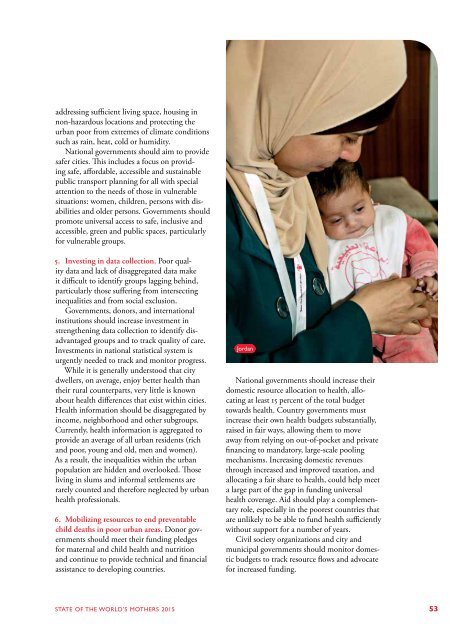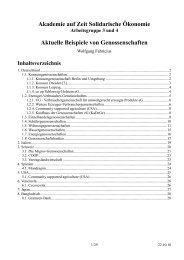sowm_2015__int__africa_full_report_low_res
sowm_2015__int__africa_full_report_low_res
sowm_2015__int__africa_full_report_low_res
Create successful ePaper yourself
Turn your PDF publications into a flip-book with our unique Google optimized e-Paper software.
add<strong>res</strong>sing sufficient living space, housing in<br />
non-hazardous locations and protecting the<br />
urban poor from extremes of climate conditions<br />
such as rain, heat, cold or humidity.<br />
National governments should aim to provide<br />
safer cities. This includes a focus on providing<br />
safe, affordable, accessible and sustainable<br />
public transport planning for all with special<br />
attention to the needs of those in vulnerable<br />
situations: women, children, persons with disabilities<br />
and older persons. Governments should<br />
promote universal access to safe, inclusive and<br />
accessible, green and public spaces, particularly<br />
for vulnerable groups.<br />
5. Investing in data collection. Poor quality<br />
data and lack of disaggregated data make<br />
it difficult to identify groups lagging behind,<br />
particularly those suffering from <strong>int</strong>ersecting<br />
inequalities and from social exclusion.<br />
Governments, donors, and <strong>int</strong>ernational<br />
institutions should increase investment in<br />
strengthening data collection to identify disadvantaged<br />
groups and to track quality of care.<br />
Investments in national statistical system is<br />
urgently needed to track and monitor prog<strong>res</strong>s.<br />
While it is generally understood that city<br />
dwellers, on average, enjoy better health than<br />
their rural counterparts, very little is known<br />
about health differences that exist within cities.<br />
Health information should be disaggregated by<br />
income, neighborhood and other subgroups.<br />
Currently, health information is aggregated to<br />
provide an average of all urban <strong>res</strong>idents (rich<br />
and poor, young and old, men and women).<br />
As a <strong>res</strong>ult, the inequalities within the urban<br />
population are hidden and overlooked. Those<br />
living in slums and informal settlements are<br />
rarely counted and therefore neglected by urban<br />
health professionals.<br />
6. Mobilizing <strong>res</strong>ources to end preventable<br />
child deaths in poor urban areas. Donor governments<br />
should meet their funding pledges<br />
for maternal and child health and nutrition<br />
and continue to provide technical and financial<br />
assistance to developing countries.<br />
Jordan<br />
National governments should increase their<br />
domestic <strong>res</strong>ource allocation to health, allocating<br />
at least 15 percent of the total budget<br />
towards health. Country governments must<br />
increase their own health budgets substantially,<br />
raised in fair ways, al<strong>low</strong>ing them to move<br />
away from relying on out-of-pocket and private<br />
financing to mandatory, large-scale pooling<br />
mechanisms. Increasing domestic revenues<br />
through increased and improved taxation, and<br />
allocating a fair share to health, could help meet<br />
a large part of the gap in funding universal<br />
health coverage. Aid should play a complementary<br />
role, especially in the poo<strong>res</strong>t countries that<br />
are unlikely to be able to fund health sufficiently<br />
without support for a number of years.<br />
Civil society organizations and city and<br />
municipal governments should monitor domestic<br />
budgets to track <strong>res</strong>ource f<strong>low</strong>s and advocate<br />
for increased funding.<br />
STATE OF THE WORLD’S MOTHERS <strong>2015</strong> 53




